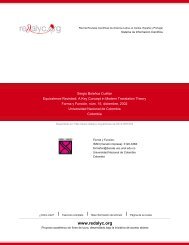Portraits of the spiritual Seeing in Mark's Gospel. Origen ... - Redalyc
Portraits of the spiritual Seeing in Mark's Gospel. Origen ... - Redalyc
Portraits of the spiritual Seeing in Mark's Gospel. Origen ... - Redalyc
Create successful ePaper yourself
Turn your PDF publications into a flip-book with our unique Google optimized e-Paper software.
Jesus and <strong>the</strong> Demons:...<br />
309<br />
simultaneously <strong>the</strong> body and soul to elevate <strong>the</strong> person to <strong>the</strong> po<strong>in</strong>t<br />
that he or she can be considered a <strong>spiritual</strong> person. The physical and<br />
<strong>spiritual</strong> senses are <strong>in</strong>terrelated to <strong>the</strong> po<strong>in</strong>t that <strong>the</strong> latter helps <strong>the</strong><br />
former to perceive better <strong>the</strong> reality <strong>of</strong> <strong>the</strong> world, serv<strong>in</strong>g as a platform<br />
for <strong>the</strong> true mystical perception <strong>of</strong> <strong>the</strong> div<strong>in</strong>e reality, as it is proposed<br />
by Corrigan: «<strong>the</strong> <strong>spiritual</strong> senses may well represent a more immediate<br />
and concrete way <strong>of</strong> see<strong>in</strong>g, a prelude to <strong>the</strong> greater immediacy <strong>of</strong><br />
mystical see<strong>in</strong>g» 2 . At this po<strong>in</strong>t, all <strong>the</strong> functions <strong>of</strong> <strong>the</strong> person become<br />
<strong>spiritual</strong> to <strong>the</strong> level that he/she reasons and acts through <strong>the</strong> <strong>spiritual</strong><br />
<strong>in</strong>tellect and will. Therefore <strong>the</strong> perceptions <strong>of</strong> <strong>the</strong> visible and <strong>in</strong>visible<br />
world are done through <strong>the</strong> <strong>spiritual</strong> heart, <strong>the</strong> <strong>spiritual</strong> imag<strong>in</strong>ation,<br />
and <strong>the</strong> <strong>spiritual</strong> senses. This phenomenon cannot be treated just only<br />
from a psychological po<strong>in</strong>t <strong>of</strong> view, because it goes beyond <strong>the</strong> human<br />
psychology touch<strong>in</strong>g <strong>the</strong> realm <strong>of</strong> <strong>the</strong> spirit. Consequently, it must be<br />
studied from a <strong>the</strong>ological po<strong>in</strong>t <strong>of</strong> view. Then, <strong>the</strong> aes<strong>the</strong>tic experience<br />
<strong>of</strong> a believer becomes <strong>spiritual</strong>, <strong>in</strong> <strong>the</strong> sense that his or her <strong>spiritual</strong><br />
sensibility unites <strong>the</strong> paradoxical extreme <strong>of</strong> <strong>the</strong> corporeal and <strong>spiritual</strong><br />
means <strong>of</strong> perception <strong>in</strong> order to have a total and <strong>in</strong>tegrated experience<br />
<strong>of</strong> <strong>the</strong> visible and <strong>in</strong>visible world 3 .<br />
Balthasar, <strong>in</strong> a very syn<strong>the</strong>tic statement, establishes three loci classici<br />
from where <strong>the</strong> notions <strong>of</strong> <strong>the</strong> <strong>spiritual</strong> senses had been shaped through<br />
<strong>the</strong> Christian history. These are <strong>the</strong> writ<strong>in</strong>gs <strong>of</strong> three illustrious figures:<br />
<strong>Origen</strong>, Bonaventure and Ignatius <strong>of</strong> Loyola 4 .<br />
One <strong>of</strong> <strong>the</strong> first explicit written manifestations <strong>of</strong> <strong>the</strong> <strong>spiritual</strong> senses’<br />
conception can be found <strong>in</strong> <strong>Origen</strong>, who developed it, <strong>in</strong> his own way,<br />
on <strong>the</strong> basis <strong>of</strong> his Platonic and Biblical analysis. His <strong>in</strong>fluence cont<strong>in</strong>ued<br />
through <strong>the</strong> patristic period but <strong>the</strong> written manifestations <strong>of</strong> <strong>the</strong> notion<br />
were not as systematic and evident as it can be read <strong>in</strong> <strong>Origen</strong>’s writ<strong>in</strong>gs.<br />
Through his allegorical application <strong>of</strong> exegesis, <strong>Origen</strong> perceived <strong>the</strong><br />
<strong>spiritual</strong> mean<strong>in</strong>g <strong>of</strong> <strong>the</strong> text that is already rooted <strong>in</strong> its literal sense. In<br />
this manner he constructed his notion <strong>of</strong> <strong>spiritual</strong> aes<strong>the</strong>tics tak<strong>in</strong>g <strong>in</strong><br />
consideration some pericopes like <strong>the</strong> text <strong>of</strong> Hebrews 5:14 «But solid<br />
2<br />
K. Corrigan, Evagrius and Gregory: M<strong>in</strong>d, Soul and Body <strong>in</strong> <strong>the</strong> 4th Century<br />
(Farham, UK: Ashgate, 2009) 128.<br />
3<br />
Cf. H. U. von Balthasar, The Glory <strong>of</strong> <strong>the</strong> Lord. A <strong>the</strong>ological Aes<strong>the</strong>tics (New York<br />
1982) I, 366-367.<br />
4<br />
H. U. von Balthasar, The Glory…, 367–368.372.373.
















